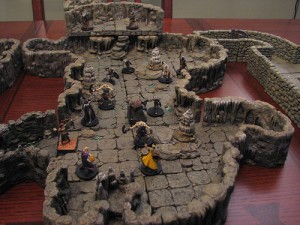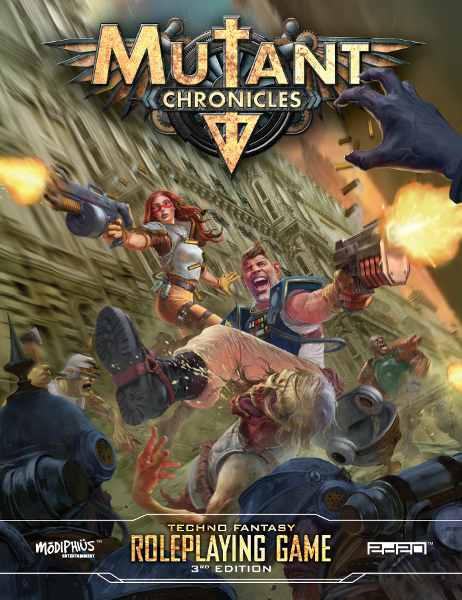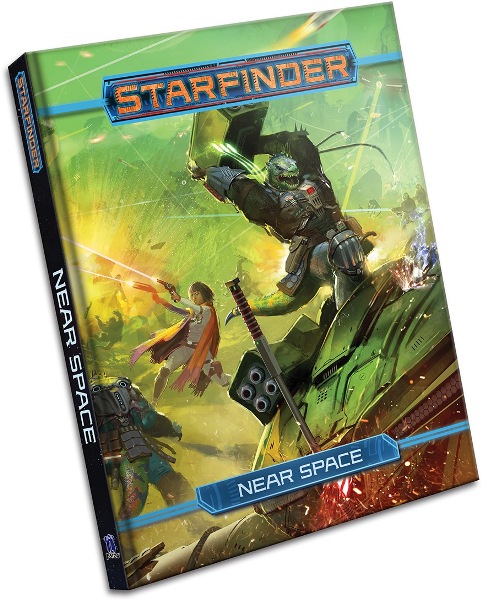The Problem with Props
By The Warden

Before we begin, as the Official Canadian Correspondent for Roleplayer’s Chronicle, it is my duty to inform you today is Canada Day, also known as Canada’s 145th birthday. Not that it has any bearing on today’s topic for Under the Hood, but I would be slipping in my duties had I not shared that fact with my fellow geeks.
Now down to business.
As I’m packing up for a weekend at the cabin, for which only one evening will be spent gaming (sigh), it strikes me how much I hate to pack, mainly because it seems far too easy to forget one tiny object, rendering the rest of my efforts fruitless. If I forget to pack my bathing suit, I just wasted all the space and time with the towels, sunscreen, and cramming the beach ball in the trunk. And because I’m hopelessly pathetic with little need for an excuse to translate any thought into gaming, it begins to dawn on me how I feel this way about accessories for any RPG. It has happened before where I went to so much trouble ensuring I had every single book, miniature, and map the adventure required, my dice were left sitting on my bedside table.
THE RISE OF PROPS
While I struggle to zip up this stupid suitcase, go ahead and watch this video by resident mild-mannered socialite, the Dungeon Bastard.
Dungeon Bastard: Battlemat vs. Theatre of the Mind
Using props in roleplaying games today has become par for the course. Even the simple battlemap requires a slew of additional miniatures – pewter, plastic, or cardboard – and can easily lead some into terrain pieces, a collection of exterior and interior battlemaps, custom constructions, and enough material to warrant a film crew and claymation characters. You can even drop a few thousand dollars on an ultimate gaming table, the Sultan. Such an expansion is not a surprise as the majority of these purchasers are adult gamers with stable careers, a steady income, and the means to do what they always wished they could do when they were teenagers in their parents’ basement. And like everything else in any geek community, whether or not RPGs are best served to use props can become quite a divisive issue.
Myself, I don’t have many props other than a few scant miniatures and maps stored in the basement. Not because I’m against using them, but because I’m poor. (What’s that, you say? How could an aspiring RPG designer suffer from poverty? Man, I wish I knew that ahead of time.) I do, however, play in many campaigns with an abundance of props available, particularly battlemaps and minis. When I do apply props in my games, they are customized handouts assembled through the aid of hi-tech printers and presses and laughable security at the various printing companies I used to work for back in the day.
During my teenage years, I had the great fortune of playing with some incredibly inventive minds with the desire and ability to construct some magnificent props. One such event included a secret layer of a Dark Sun temple concealed under the dining room table, revealed when the DM asked the player on the other side to pull on his end. Where grown-ups would place an extension for Christmas dinner, he had built a miniature replica of the secret layer and kept it under our noses for hours at a time. The emphasis of this recollection is “built.”
While miniatures depicting our fiercest monsters and valiant heroes have been around for years, the past decade has brought about a flurry of additional pre-assembled or manufactured accessories like the aforementioned battlemap, terrain pieces, dungeon walls, RPG-themed soundtracks, character artwork services, full-color poster maps, and more, more, MORE!! Even the PDF industry has followed suit with Fat Dragon Games and their endless line of printable terrain sets frequently sitting on the top of RPGNow’s Best Sellers. No longer does the world of our wildest, non-sexual fantasies take place in our mind, they are played out on our tables.
A NATURAL PROGRESSION
Easy though it may be to point fingers at greedy executives and denounce them for trying to corrupt a pure hobby like roleplaying, we have only ourselves to blame. We bought all the supplements produced for our favorite RPGs, no matter how relevant they were to our current campaigns or timelines – I’m looking at you, Rifts – and clamored for more to the point many publishers have gone bankrupt in an effort to keep up with the rabid demand in such a tiny empire. It was only a matter of time before other entrepreneurs turned to producing generic props for use in nearly any RPG (or at least something appropriate to the genre).
What exists now is a genre of roleplaying subservient to the use of props or designed to work in what we now seem to call the “theatre of the mind.” No surprise these genres are separated by those publishers with the budgets and resources to produce such props and the independent publishers who cannot. That’s not to say independent publishers wouldn’t jump at the chance to try their hand at props (just recently, Robertson Games was able to raise enough money on IndieGoGo to start production on a series of 6 miniatures for their Weird West RPG) but lack the capital to make such a risky venture worthwhile. And it is a risky venture, as Wizards of the Coast experienced when they had to stop production on their random D&D minis packs and retool it as Dungeon Command to make producing miniatures financially viable.
TO PROP OR NOT TO PROP
An interesting event has occurred within my own social circles: many of my fellow players find themselves unable to play any RPG without miniatures to guide them. In our regular Sunday group, we use miniatures to playtest D&D Next and the discussion on trying the game without those plastic bastards is eventually shot down. “I’m too old to remember where everyone’s standing and how many there are around you guys,” our DM tells us. After spending at least a decade positioning figures on a grid and measuring all movement in squares, many of my friends find themselves unable (or unwilling) to play in their mind.
There does seem to be a correlation between the complexity of a game and the usefulness of props to keep the game manageable. While Paizo has only recently produced miniatures bearing the Golem’s seal of approval, I have never seen a Pathfinder game in progress without miniatures. (They have been released battlemaps and other handouts for years as a supplement to their already impressive line-up.) And their rulebook is – hold on a moment – 576 pages. There is no component to Pathfinder’s design indicating miniatures are required. For example, all measurement is given in feet, not squares. Yet if we turn back to an earlier example of independent game design, Weird West by Robertson Games, it clocks in at 8 pages and none of my research into the game mentions anything about mandatory play with miniatures. Many RPGs known as story games highlight imaginative mechanics over prop design as one of their main features and their page count is fractional compared to the big guns in the business and only independent publishers are creating story games.
Is prop manufacturing and availability considered an essential device in major RPG productions today? It certainly seems so and it does give cause for concern regarding the future of our beloved hobby. Not so much for its overall survival (that would be the exact opposite of what I wrote last week), but it can have a significant impact on the publishers looking to enter the hobby. It’s capitalism at its worst, an indicative story repeated in businesses around the world. Take Research In Motion as an example with their creation, the BlackBerry. While they rose to the top in the early days of smart phones, they’re struggling to make ends meet in competition with heavy hitters like Apple. It’s a scenario easily equitable with RPGs and board games. Are major publishers trying too hard to meet our demands and are we asking for too much from our publishers?
These are complicated questions requiring even more complicated answers involving multiple subjects, but can culminate into a difficult situation; one I feel may become far too likely in the near future. As we all know, Hasbro owns Wizards of the Coast and they own the D&D brand. What happens if WotC attempts to liquidate that license for any number of theoretical reasons? Because of the massive cash invested into the brand and the expectation of value as a brand owned by Hasbro, would there be any publisher or manufacturer who could afford to buy the D&D name? Or would its rise to fame become its downfall? Remember, Wizards of the Coast was a larger publisher involved with the massively popular trading card game business, making it feasible for them to buy the brand from TSR above all others, so this hypothetical situation is simply an extension of that moment in 1997. While such an event is not a threat to the hobby as a whole, it is a threat to the major players in the field and can be the end result of our own insatiable appetite for more toys.
It’s dilemmas like this I’m sure other markets would kill to have: an audience demanding more than the current market can possibly provide. For RPGs, the question is not demand per consumer, but the number of consumers available to purchase the products. And believe me, the last thing I’m trying to do is advocate fewer RPG purchases. Perhaps this is yet another call for our games to return to their roots, like everything else from childhood. It’s the curse of adulthood to dream of things as they once were or as we perceived them. Regardless of which side of the expense fence you sit on, you cannot deny the fact that it’s easier to introduce new players to the game when there’s little to no start-up cost involved.


